Gender Inequality at Workplaces: Challenges and HR Recommendations
VerifiedAdded on 2023/06/15
|15
|3511
|116
AI Summary
The report focuses on gender inequality at workplaces being a complex phenomenon in HR practices, organizational structures and processes. Gender inequality in terms of pay, promotion, hiring, job descriptions create unfavorable climate for women hindering their achievement and success. Therefore, HRM should implement practices that help to eliminate gender discrimination and promote gender equality at workplaces.
Contribute Materials
Your contribution can guide someone’s learning journey. Share your
documents today.
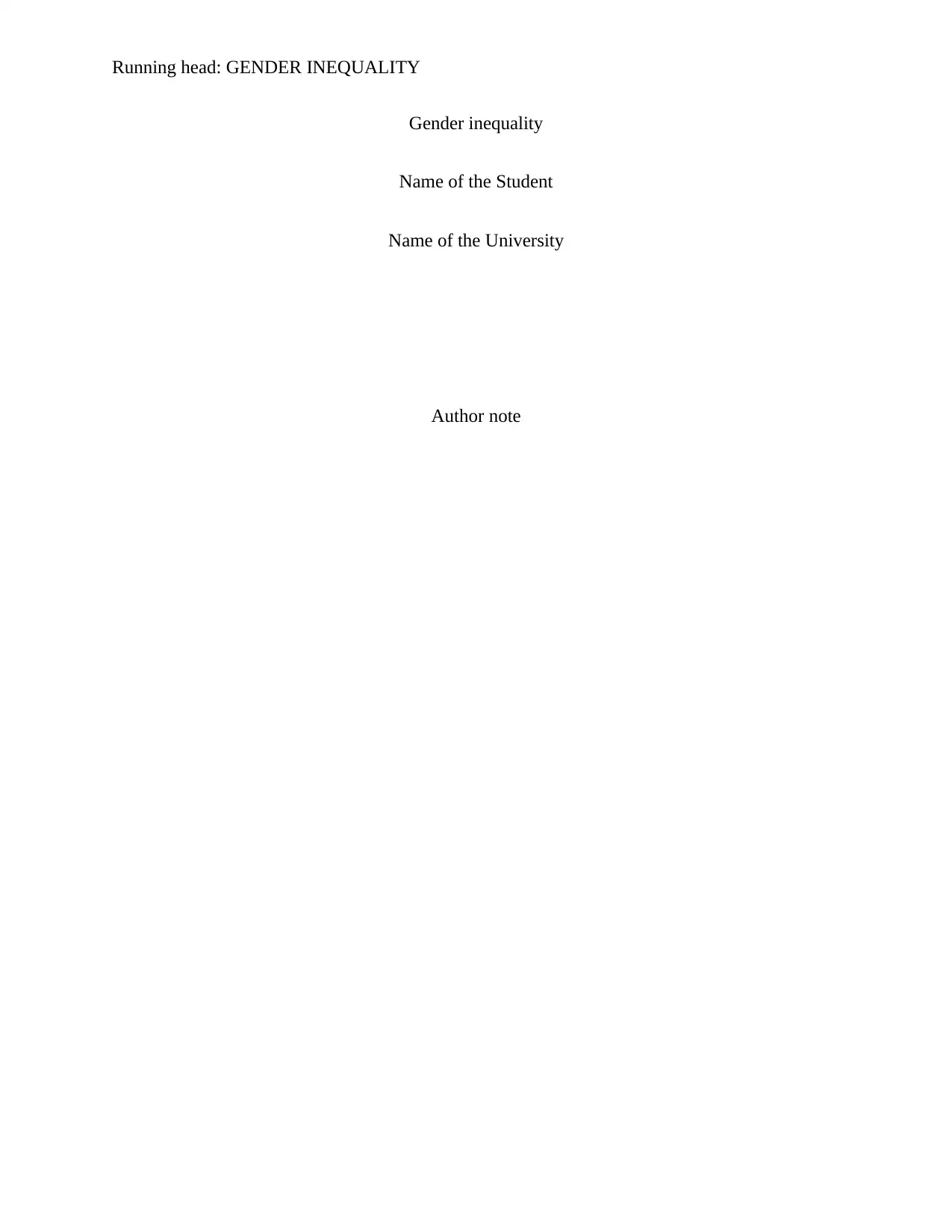
Running head: GENDER INEQUALITY
Gender inequality
Name of the Student
Name of the University
Author note
Gender inequality
Name of the Student
Name of the University
Author note
Secure Best Marks with AI Grader
Need help grading? Try our AI Grader for instant feedback on your assignments.
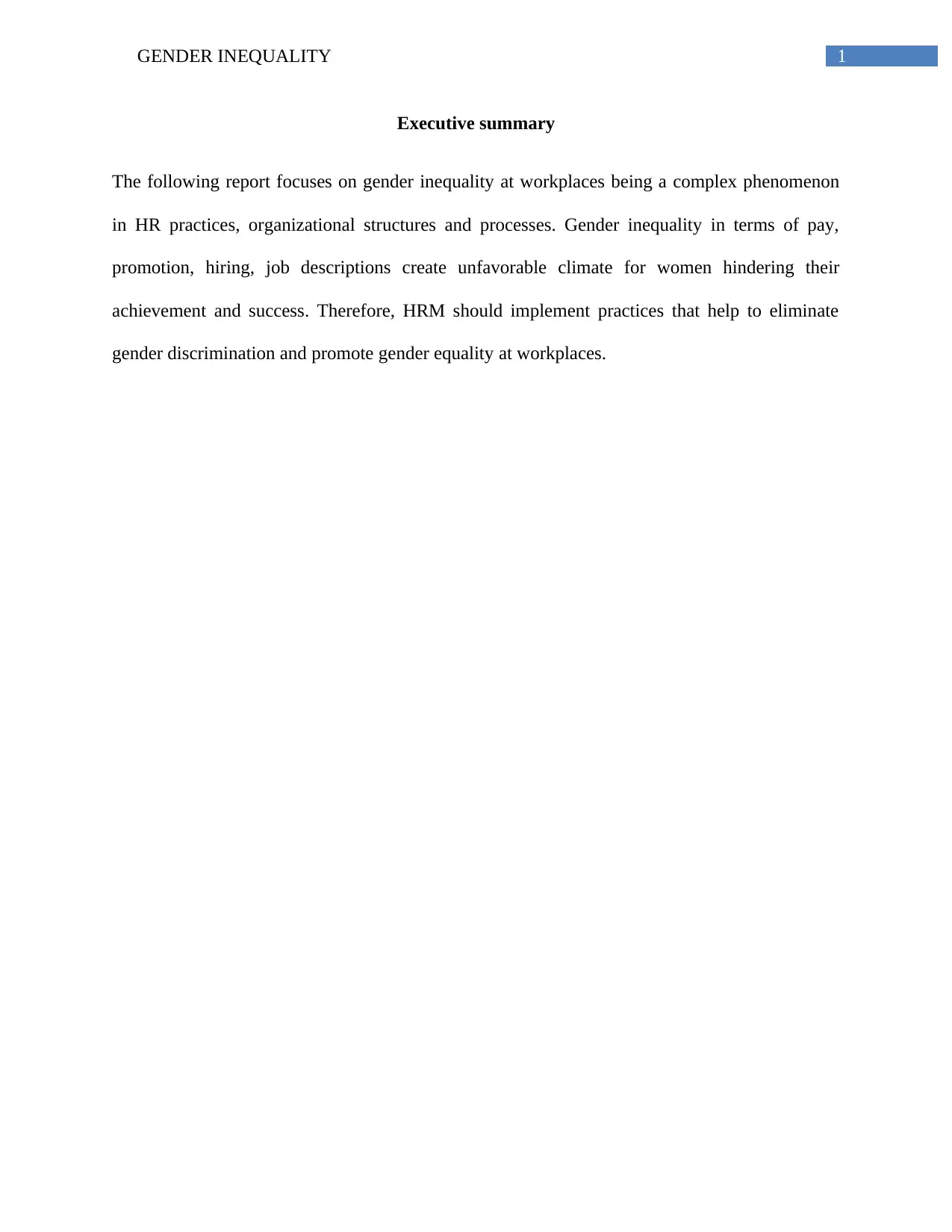
1GENDER INEQUALITY
Executive summary
The following report focuses on gender inequality at workplaces being a complex phenomenon
in HR practices, organizational structures and processes. Gender inequality in terms of pay,
promotion, hiring, job descriptions create unfavorable climate for women hindering their
achievement and success. Therefore, HRM should implement practices that help to eliminate
gender discrimination and promote gender equality at workplaces.
Executive summary
The following report focuses on gender inequality at workplaces being a complex phenomenon
in HR practices, organizational structures and processes. Gender inequality in terms of pay,
promotion, hiring, job descriptions create unfavorable climate for women hindering their
achievement and success. Therefore, HRM should implement practices that help to eliminate
gender discrimination and promote gender equality at workplaces.
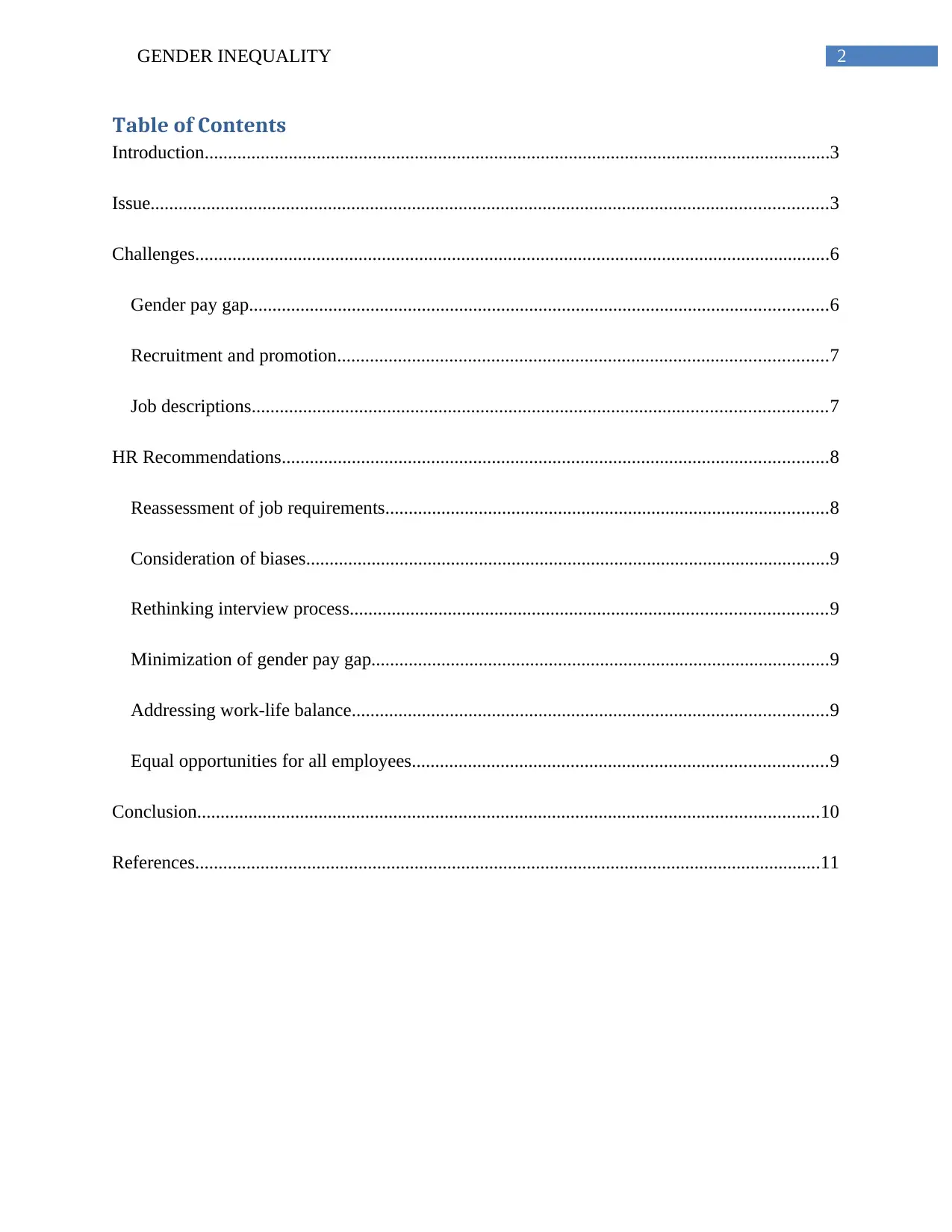
2GENDER INEQUALITY
Table of Contents
Introduction......................................................................................................................................3
Issue.................................................................................................................................................3
Challenges........................................................................................................................................6
Gender pay gap............................................................................................................................6
Recruitment and promotion.........................................................................................................7
Job descriptions...........................................................................................................................7
HR Recommendations.....................................................................................................................8
Reassessment of job requirements...............................................................................................8
Consideration of biases................................................................................................................9
Rethinking interview process......................................................................................................9
Minimization of gender pay gap..................................................................................................9
Addressing work-life balance......................................................................................................9
Equal opportunities for all employees.........................................................................................9
Conclusion.....................................................................................................................................10
References......................................................................................................................................11
Table of Contents
Introduction......................................................................................................................................3
Issue.................................................................................................................................................3
Challenges........................................................................................................................................6
Gender pay gap............................................................................................................................6
Recruitment and promotion.........................................................................................................7
Job descriptions...........................................................................................................................7
HR Recommendations.....................................................................................................................8
Reassessment of job requirements...............................................................................................8
Consideration of biases................................................................................................................9
Rethinking interview process......................................................................................................9
Minimization of gender pay gap..................................................................................................9
Addressing work-life balance......................................................................................................9
Equal opportunities for all employees.........................................................................................9
Conclusion.....................................................................................................................................10
References......................................................................................................................................11
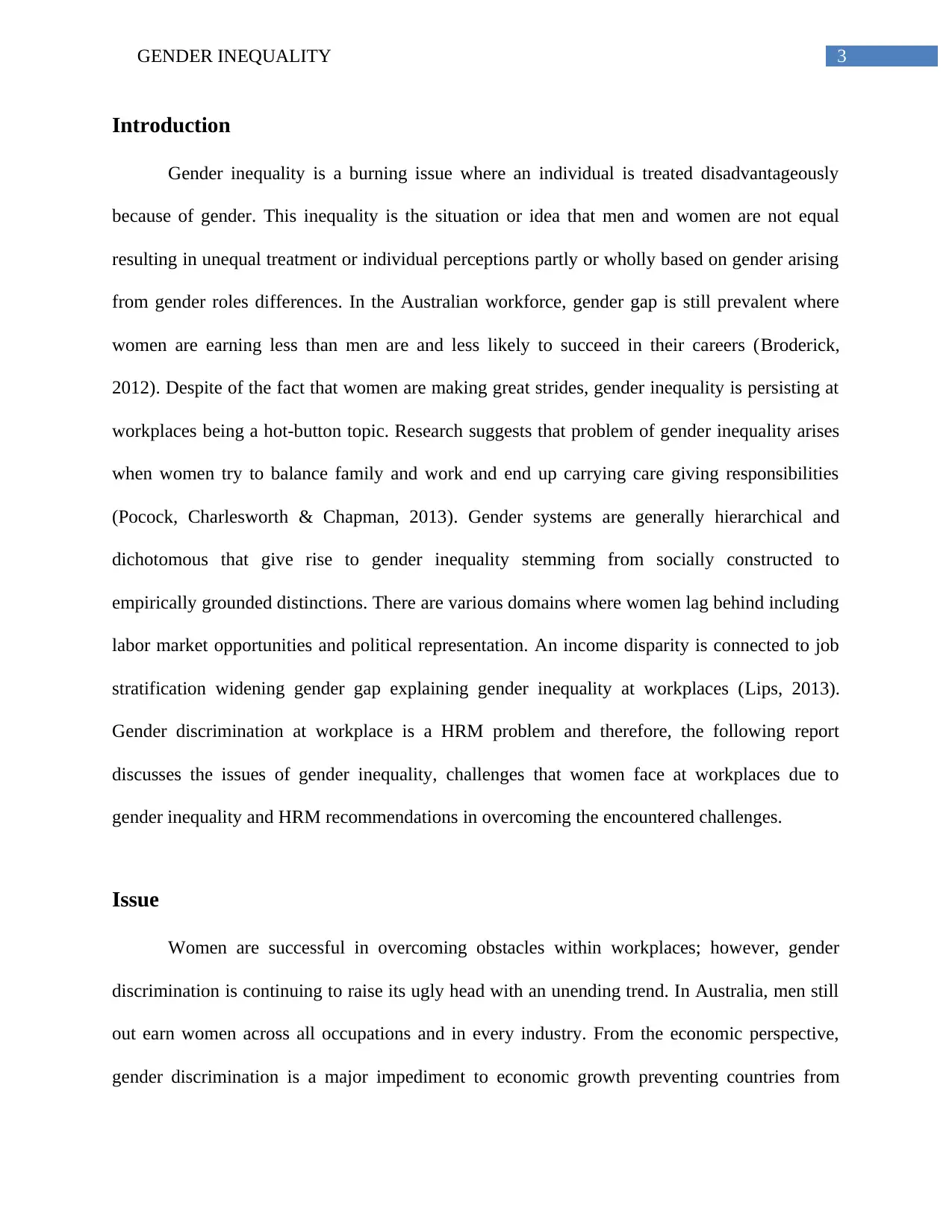
3GENDER INEQUALITY
Introduction
Gender inequality is a burning issue where an individual is treated disadvantageously
because of gender. This inequality is the situation or idea that men and women are not equal
resulting in unequal treatment or individual perceptions partly or wholly based on gender arising
from gender roles differences. In the Australian workforce, gender gap is still prevalent where
women are earning less than men are and less likely to succeed in their careers (Broderick,
2012). Despite of the fact that women are making great strides, gender inequality is persisting at
workplaces being a hot-button topic. Research suggests that problem of gender inequality arises
when women try to balance family and work and end up carrying care giving responsibilities
(Pocock, Charlesworth & Chapman, 2013). Gender systems are generally hierarchical and
dichotomous that give rise to gender inequality stemming from socially constructed to
empirically grounded distinctions. There are various domains where women lag behind including
labor market opportunities and political representation. An income disparity is connected to job
stratification widening gender gap explaining gender inequality at workplaces (Lips, 2013).
Gender discrimination at workplace is a HRM problem and therefore, the following report
discusses the issues of gender inequality, challenges that women face at workplaces due to
gender inequality and HRM recommendations in overcoming the encountered challenges.
Issue
Women are successful in overcoming obstacles within workplaces; however, gender
discrimination is continuing to raise its ugly head with an unending trend. In Australia, men still
out earn women across all occupations and in every industry. From the economic perspective,
gender discrimination is a major impediment to economic growth preventing countries from
Introduction
Gender inequality is a burning issue where an individual is treated disadvantageously
because of gender. This inequality is the situation or idea that men and women are not equal
resulting in unequal treatment or individual perceptions partly or wholly based on gender arising
from gender roles differences. In the Australian workforce, gender gap is still prevalent where
women are earning less than men are and less likely to succeed in their careers (Broderick,
2012). Despite of the fact that women are making great strides, gender inequality is persisting at
workplaces being a hot-button topic. Research suggests that problem of gender inequality arises
when women try to balance family and work and end up carrying care giving responsibilities
(Pocock, Charlesworth & Chapman, 2013). Gender systems are generally hierarchical and
dichotomous that give rise to gender inequality stemming from socially constructed to
empirically grounded distinctions. There are various domains where women lag behind including
labor market opportunities and political representation. An income disparity is connected to job
stratification widening gender gap explaining gender inequality at workplaces (Lips, 2013).
Gender discrimination at workplace is a HRM problem and therefore, the following report
discusses the issues of gender inequality, challenges that women face at workplaces due to
gender inequality and HRM recommendations in overcoming the encountered challenges.
Issue
Women are successful in overcoming obstacles within workplaces; however, gender
discrimination is continuing to raise its ugly head with an unending trend. In Australia, men still
out earn women across all occupations and in every industry. From the economic perspective,
gender discrimination is a major impediment to economic growth preventing countries from
Secure Best Marks with AI Grader
Need help grading? Try our AI Grader for instant feedback on your assignments.
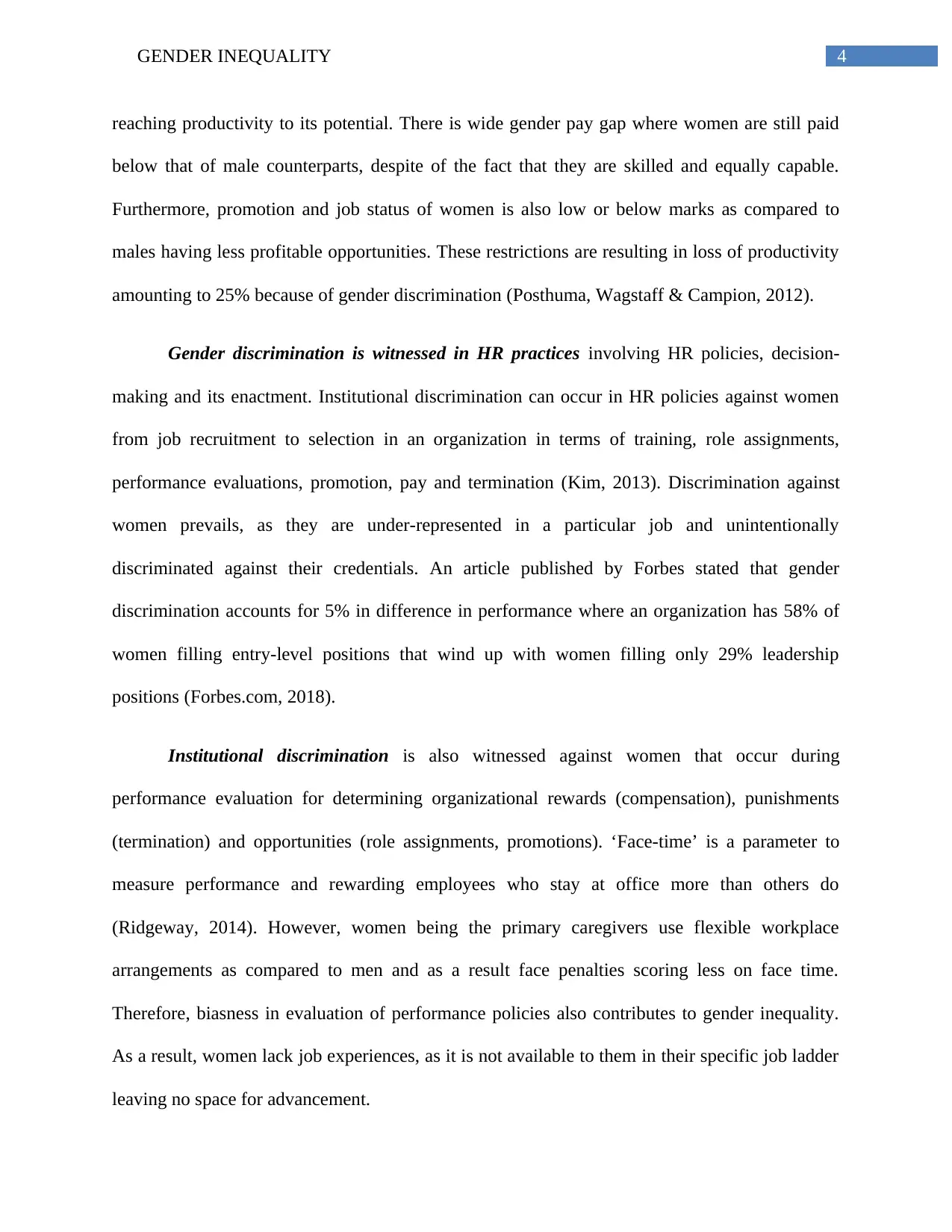
4GENDER INEQUALITY
reaching productivity to its potential. There is wide gender pay gap where women are still paid
below that of male counterparts, despite of the fact that they are skilled and equally capable.
Furthermore, promotion and job status of women is also low or below marks as compared to
males having less profitable opportunities. These restrictions are resulting in loss of productivity
amounting to 25% because of gender discrimination (Posthuma, Wagstaff & Campion, 2012).
Gender discrimination is witnessed in HR practices involving HR policies, decision-
making and its enactment. Institutional discrimination can occur in HR policies against women
from job recruitment to selection in an organization in terms of training, role assignments,
performance evaluations, promotion, pay and termination (Kim, 2013). Discrimination against
women prevails, as they are under-represented in a particular job and unintentionally
discriminated against their credentials. An article published by Forbes stated that gender
discrimination accounts for 5% in difference in performance where an organization has 58% of
women filling entry-level positions that wind up with women filling only 29% leadership
positions (Forbes.com, 2018).
Institutional discrimination is also witnessed against women that occur during
performance evaluation for determining organizational rewards (compensation), punishments
(termination) and opportunities (role assignments, promotions). ‘Face-time’ is a parameter to
measure performance and rewarding employees who stay at office more than others do
(Ridgeway, 2014). However, women being the primary caregivers use flexible workplace
arrangements as compared to men and as a result face penalties scoring less on face time.
Therefore, biasness in evaluation of performance policies also contributes to gender inequality.
As a result, women lack job experiences, as it is not available to them in their specific job ladder
leaving no space for advancement.
reaching productivity to its potential. There is wide gender pay gap where women are still paid
below that of male counterparts, despite of the fact that they are skilled and equally capable.
Furthermore, promotion and job status of women is also low or below marks as compared to
males having less profitable opportunities. These restrictions are resulting in loss of productivity
amounting to 25% because of gender discrimination (Posthuma, Wagstaff & Campion, 2012).
Gender discrimination is witnessed in HR practices involving HR policies, decision-
making and its enactment. Institutional discrimination can occur in HR policies against women
from job recruitment to selection in an organization in terms of training, role assignments,
performance evaluations, promotion, pay and termination (Kim, 2013). Discrimination against
women prevails, as they are under-represented in a particular job and unintentionally
discriminated against their credentials. An article published by Forbes stated that gender
discrimination accounts for 5% in difference in performance where an organization has 58% of
women filling entry-level positions that wind up with women filling only 29% leadership
positions (Forbes.com, 2018).
Institutional discrimination is also witnessed against women that occur during
performance evaluation for determining organizational rewards (compensation), punishments
(termination) and opportunities (role assignments, promotions). ‘Face-time’ is a parameter to
measure performance and rewarding employees who stay at office more than others do
(Ridgeway, 2014). However, women being the primary caregivers use flexible workplace
arrangements as compared to men and as a result face penalties scoring less on face time.
Therefore, biasness in evaluation of performance policies also contributes to gender inequality.
As a result, women lack job experiences, as it is not available to them in their specific job ladder
leaving no space for advancement.
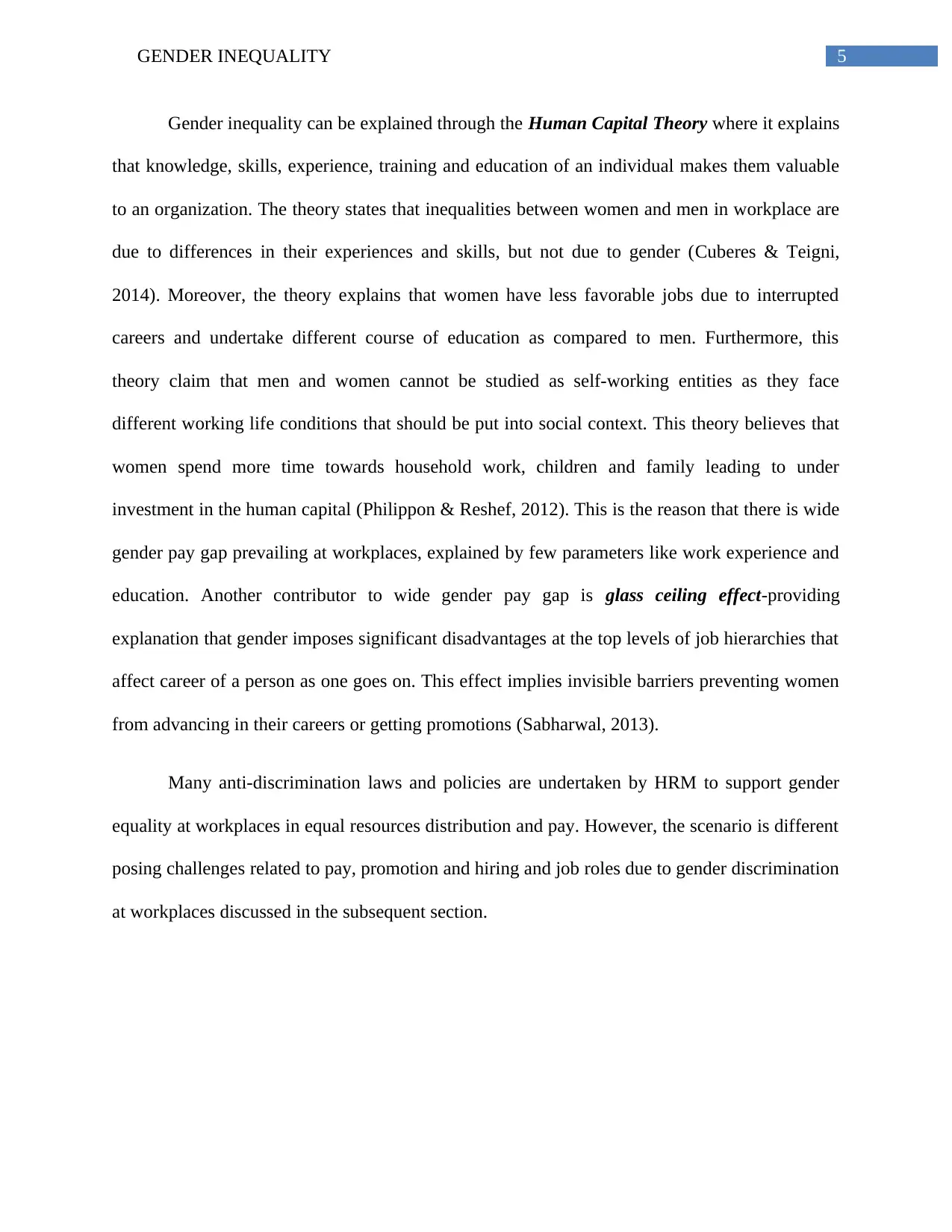
5GENDER INEQUALITY
Gender inequality can be explained through the Human Capital Theory where it explains
that knowledge, skills, experience, training and education of an individual makes them valuable
to an organization. The theory states that inequalities between women and men in workplace are
due to differences in their experiences and skills, but not due to gender (Cuberes & Teigni,
2014). Moreover, the theory explains that women have less favorable jobs due to interrupted
careers and undertake different course of education as compared to men. Furthermore, this
theory claim that men and women cannot be studied as self-working entities as they face
different working life conditions that should be put into social context. This theory believes that
women spend more time towards household work, children and family leading to under
investment in the human capital (Philippon & Reshef, 2012). This is the reason that there is wide
gender pay gap prevailing at workplaces, explained by few parameters like work experience and
education. Another contributor to wide gender pay gap is glass ceiling effect-providing
explanation that gender imposes significant disadvantages at the top levels of job hierarchies that
affect career of a person as one goes on. This effect implies invisible barriers preventing women
from advancing in their careers or getting promotions (Sabharwal, 2013).
Many anti-discrimination laws and policies are undertaken by HRM to support gender
equality at workplaces in equal resources distribution and pay. However, the scenario is different
posing challenges related to pay, promotion and hiring and job roles due to gender discrimination
at workplaces discussed in the subsequent section.
Gender inequality can be explained through the Human Capital Theory where it explains
that knowledge, skills, experience, training and education of an individual makes them valuable
to an organization. The theory states that inequalities between women and men in workplace are
due to differences in their experiences and skills, but not due to gender (Cuberes & Teigni,
2014). Moreover, the theory explains that women have less favorable jobs due to interrupted
careers and undertake different course of education as compared to men. Furthermore, this
theory claim that men and women cannot be studied as self-working entities as they face
different working life conditions that should be put into social context. This theory believes that
women spend more time towards household work, children and family leading to under
investment in the human capital (Philippon & Reshef, 2012). This is the reason that there is wide
gender pay gap prevailing at workplaces, explained by few parameters like work experience and
education. Another contributor to wide gender pay gap is glass ceiling effect-providing
explanation that gender imposes significant disadvantages at the top levels of job hierarchies that
affect career of a person as one goes on. This effect implies invisible barriers preventing women
from advancing in their careers or getting promotions (Sabharwal, 2013).
Many anti-discrimination laws and policies are undertaken by HRM to support gender
equality at workplaces in equal resources distribution and pay. However, the scenario is different
posing challenges related to pay, promotion and hiring and job roles due to gender discrimination
at workplaces discussed in the subsequent section.
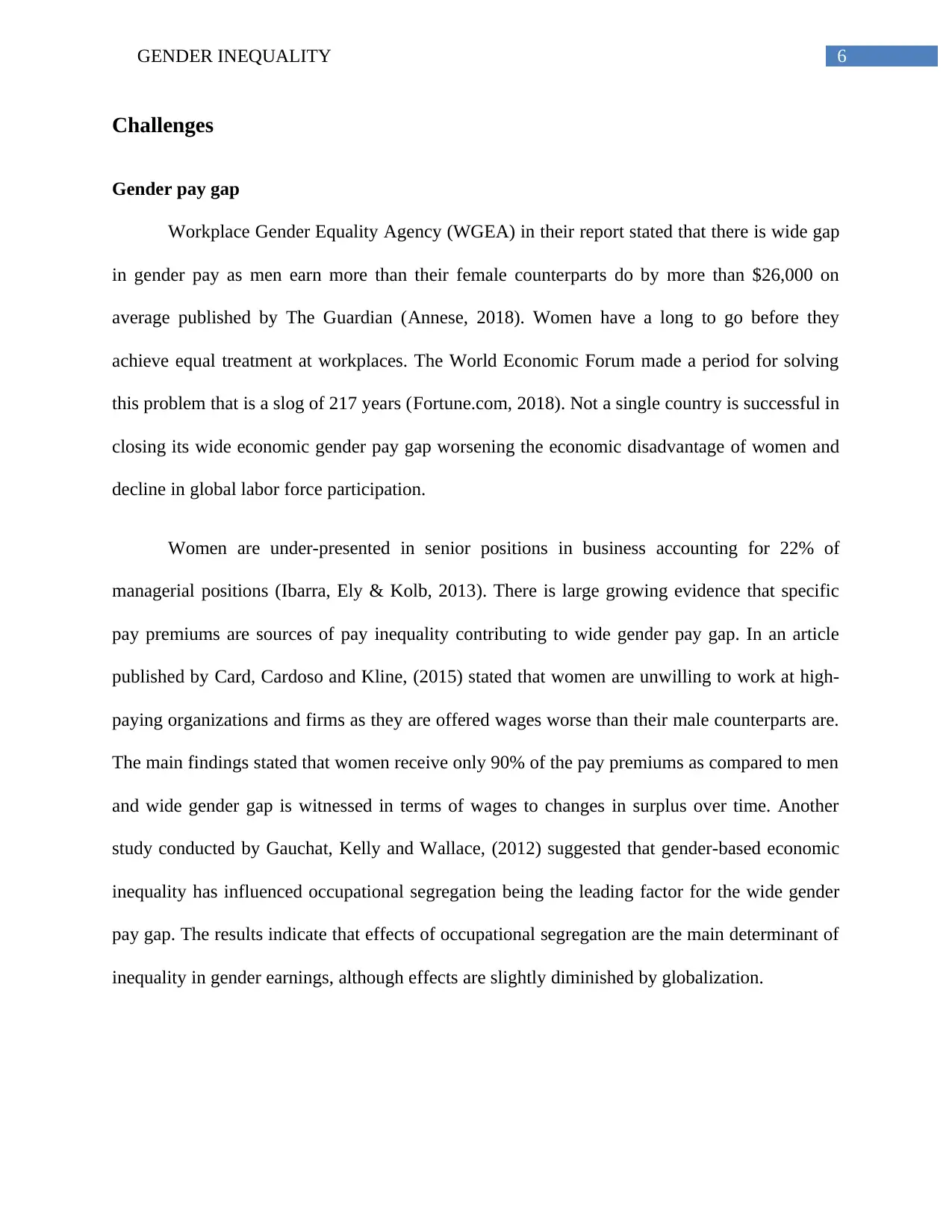
6GENDER INEQUALITY
Challenges
Gender pay gap
Workplace Gender Equality Agency (WGEA) in their report stated that there is wide gap
in gender pay as men earn more than their female counterparts do by more than $26,000 on
average published by The Guardian (Annese, 2018). Women have a long to go before they
achieve equal treatment at workplaces. The World Economic Forum made a period for solving
this problem that is a slog of 217 years (Fortune.com, 2018). Not a single country is successful in
closing its wide economic gender pay gap worsening the economic disadvantage of women and
decline in global labor force participation.
Women are under-presented in senior positions in business accounting for 22% of
managerial positions (Ibarra, Ely & Kolb, 2013). There is large growing evidence that specific
pay premiums are sources of pay inequality contributing to wide gender pay gap. In an article
published by Card, Cardoso and Kline, (2015) stated that women are unwilling to work at high-
paying organizations and firms as they are offered wages worse than their male counterparts are.
The main findings stated that women receive only 90% of the pay premiums as compared to men
and wide gender gap is witnessed in terms of wages to changes in surplus over time. Another
study conducted by Gauchat, Kelly and Wallace, (2012) suggested that gender-based economic
inequality has influenced occupational segregation being the leading factor for the wide gender
pay gap. The results indicate that effects of occupational segregation are the main determinant of
inequality in gender earnings, although effects are slightly diminished by globalization.
Challenges
Gender pay gap
Workplace Gender Equality Agency (WGEA) in their report stated that there is wide gap
in gender pay as men earn more than their female counterparts do by more than $26,000 on
average published by The Guardian (Annese, 2018). Women have a long to go before they
achieve equal treatment at workplaces. The World Economic Forum made a period for solving
this problem that is a slog of 217 years (Fortune.com, 2018). Not a single country is successful in
closing its wide economic gender pay gap worsening the economic disadvantage of women and
decline in global labor force participation.
Women are under-presented in senior positions in business accounting for 22% of
managerial positions (Ibarra, Ely & Kolb, 2013). There is large growing evidence that specific
pay premiums are sources of pay inequality contributing to wide gender pay gap. In an article
published by Card, Cardoso and Kline, (2015) stated that women are unwilling to work at high-
paying organizations and firms as they are offered wages worse than their male counterparts are.
The main findings stated that women receive only 90% of the pay premiums as compared to men
and wide gender gap is witnessed in terms of wages to changes in surplus over time. Another
study conducted by Gauchat, Kelly and Wallace, (2012) suggested that gender-based economic
inequality has influenced occupational segregation being the leading factor for the wide gender
pay gap. The results indicate that effects of occupational segregation are the main determinant of
inequality in gender earnings, although effects are slightly diminished by globalization.
Paraphrase This Document
Need a fresh take? Get an instant paraphrase of this document with our AI Paraphraser
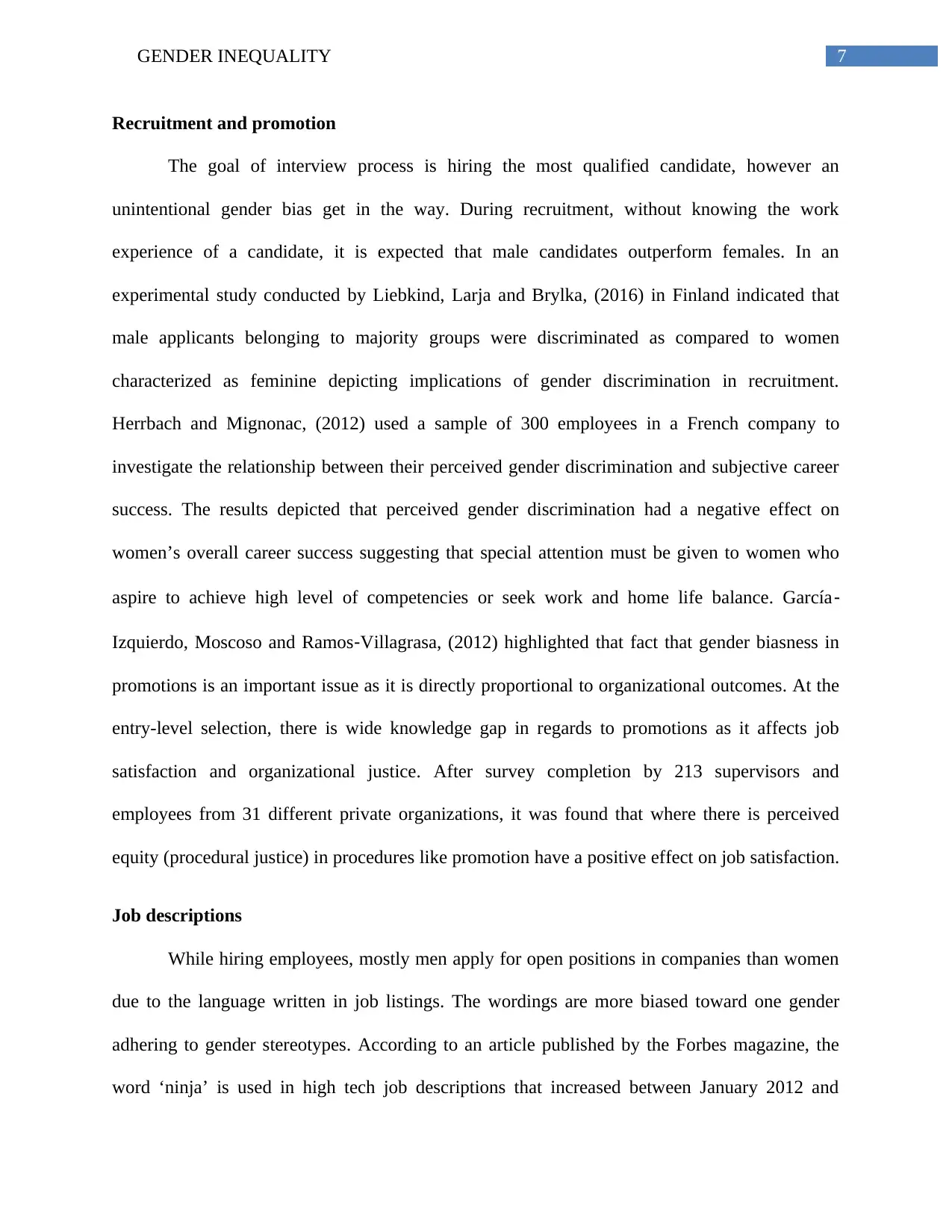
7GENDER INEQUALITY
Recruitment and promotion
The goal of interview process is hiring the most qualified candidate, however an
unintentional gender bias get in the way. During recruitment, without knowing the work
experience of a candidate, it is expected that male candidates outperform females. In an
experimental study conducted by Liebkind, Larja and Brylka, (2016) in Finland indicated that
male applicants belonging to majority groups were discriminated as compared to women
characterized as feminine depicting implications of gender discrimination in recruitment.
Herrbach and Mignonac, (2012) used a sample of 300 employees in a French company to
investigate the relationship between their perceived gender discrimination and subjective career
success. The results depicted that perceived gender discrimination had a negative effect on
women’s overall career success suggesting that special attention must be given to women who
aspire to achieve high level of competencies or seek work and home life balance. García‐
Izquierdo, Moscoso and Ramos‐Villagrasa, (2012) highlighted that fact that gender biasness in
promotions is an important issue as it is directly proportional to organizational outcomes. At the
entry-level selection, there is wide knowledge gap in regards to promotions as it affects job
satisfaction and organizational justice. After survey completion by 213 supervisors and
employees from 31 different private organizations, it was found that where there is perceived
equity (procedural justice) in procedures like promotion have a positive effect on job satisfaction.
Job descriptions
While hiring employees, mostly men apply for open positions in companies than women
due to the language written in job listings. The wordings are more biased toward one gender
adhering to gender stereotypes. According to an article published by the Forbes magazine, the
word ‘ninja’ is used in high tech job descriptions that increased between January 2012 and
Recruitment and promotion
The goal of interview process is hiring the most qualified candidate, however an
unintentional gender bias get in the way. During recruitment, without knowing the work
experience of a candidate, it is expected that male candidates outperform females. In an
experimental study conducted by Liebkind, Larja and Brylka, (2016) in Finland indicated that
male applicants belonging to majority groups were discriminated as compared to women
characterized as feminine depicting implications of gender discrimination in recruitment.
Herrbach and Mignonac, (2012) used a sample of 300 employees in a French company to
investigate the relationship between their perceived gender discrimination and subjective career
success. The results depicted that perceived gender discrimination had a negative effect on
women’s overall career success suggesting that special attention must be given to women who
aspire to achieve high level of competencies or seek work and home life balance. García‐
Izquierdo, Moscoso and Ramos‐Villagrasa, (2012) highlighted that fact that gender biasness in
promotions is an important issue as it is directly proportional to organizational outcomes. At the
entry-level selection, there is wide knowledge gap in regards to promotions as it affects job
satisfaction and organizational justice. After survey completion by 213 supervisors and
employees from 31 different private organizations, it was found that where there is perceived
equity (procedural justice) in procedures like promotion have a positive effect on job satisfaction.
Job descriptions
While hiring employees, mostly men apply for open positions in companies than women
due to the language written in job listings. The wordings are more biased toward one gender
adhering to gender stereotypes. According to an article published by the Forbes magazine, the
word ‘ninja’ is used in high tech job descriptions that increased between January 2012 and
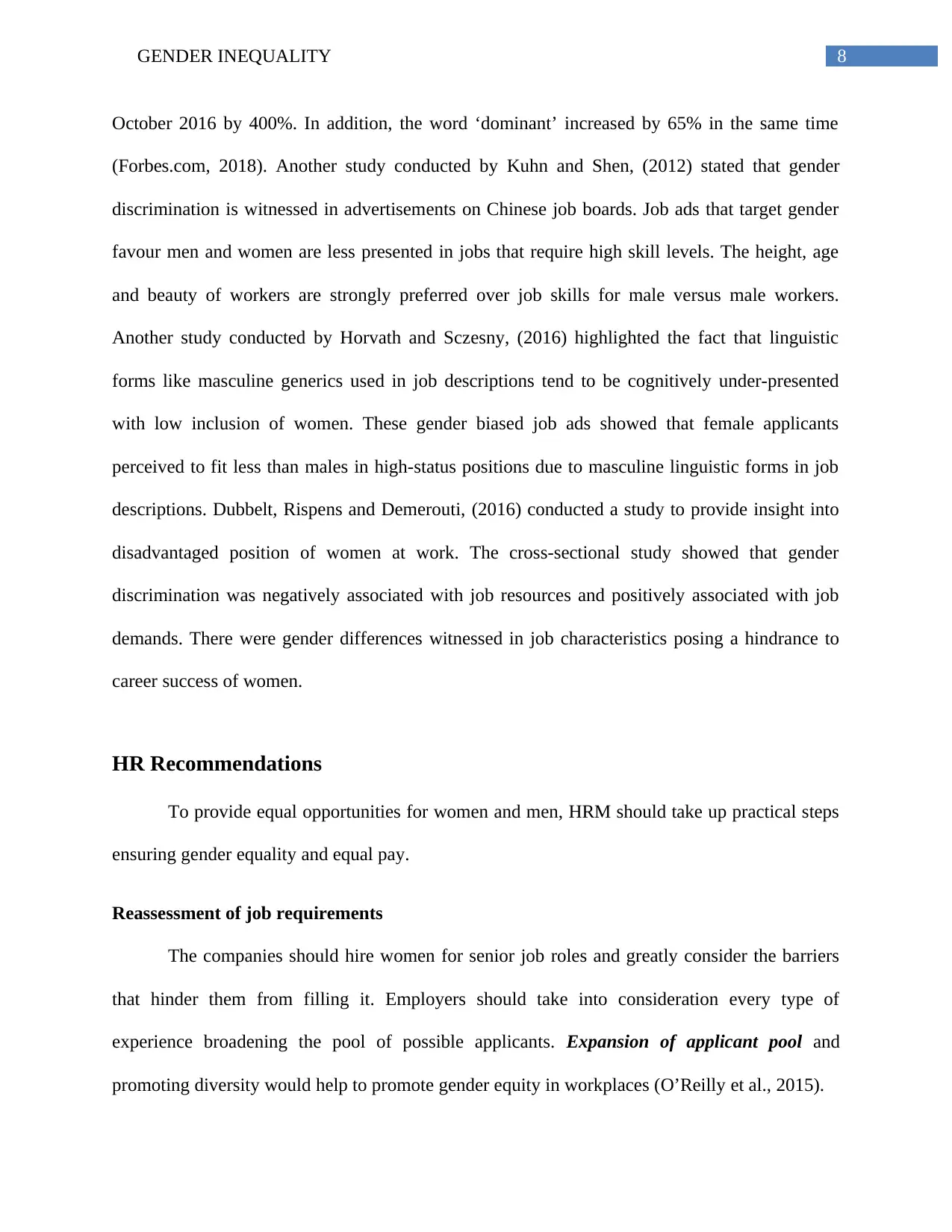
8GENDER INEQUALITY
October 2016 by 400%. In addition, the word ‘dominant’ increased by 65% in the same time
(Forbes.com, 2018). Another study conducted by Kuhn and Shen, (2012) stated that gender
discrimination is witnessed in advertisements on Chinese job boards. Job ads that target gender
favour men and women are less presented in jobs that require high skill levels. The height, age
and beauty of workers are strongly preferred over job skills for male versus male workers.
Another study conducted by Horvath and Sczesny, (2016) highlighted the fact that linguistic
forms like masculine generics used in job descriptions tend to be cognitively under-presented
with low inclusion of women. These gender biased job ads showed that female applicants
perceived to fit less than males in high-status positions due to masculine linguistic forms in job
descriptions. Dubbelt, Rispens and Demerouti, (2016) conducted a study to provide insight into
disadvantaged position of women at work. The cross-sectional study showed that gender
discrimination was negatively associated with job resources and positively associated with job
demands. There were gender differences witnessed in job characteristics posing a hindrance to
career success of women.
HR Recommendations
To provide equal opportunities for women and men, HRM should take up practical steps
ensuring gender equality and equal pay.
Reassessment of job requirements
The companies should hire women for senior job roles and greatly consider the barriers
that hinder them from filling it. Employers should take into consideration every type of
experience broadening the pool of possible applicants. Expansion of applicant pool and
promoting diversity would help to promote gender equity in workplaces (O’Reilly et al., 2015).
October 2016 by 400%. In addition, the word ‘dominant’ increased by 65% in the same time
(Forbes.com, 2018). Another study conducted by Kuhn and Shen, (2012) stated that gender
discrimination is witnessed in advertisements on Chinese job boards. Job ads that target gender
favour men and women are less presented in jobs that require high skill levels. The height, age
and beauty of workers are strongly preferred over job skills for male versus male workers.
Another study conducted by Horvath and Sczesny, (2016) highlighted the fact that linguistic
forms like masculine generics used in job descriptions tend to be cognitively under-presented
with low inclusion of women. These gender biased job ads showed that female applicants
perceived to fit less than males in high-status positions due to masculine linguistic forms in job
descriptions. Dubbelt, Rispens and Demerouti, (2016) conducted a study to provide insight into
disadvantaged position of women at work. The cross-sectional study showed that gender
discrimination was negatively associated with job resources and positively associated with job
demands. There were gender differences witnessed in job characteristics posing a hindrance to
career success of women.
HR Recommendations
To provide equal opportunities for women and men, HRM should take up practical steps
ensuring gender equality and equal pay.
Reassessment of job requirements
The companies should hire women for senior job roles and greatly consider the barriers
that hinder them from filling it. Employers should take into consideration every type of
experience broadening the pool of possible applicants. Expansion of applicant pool and
promoting diversity would help to promote gender equity in workplaces (O’Reilly et al., 2015).
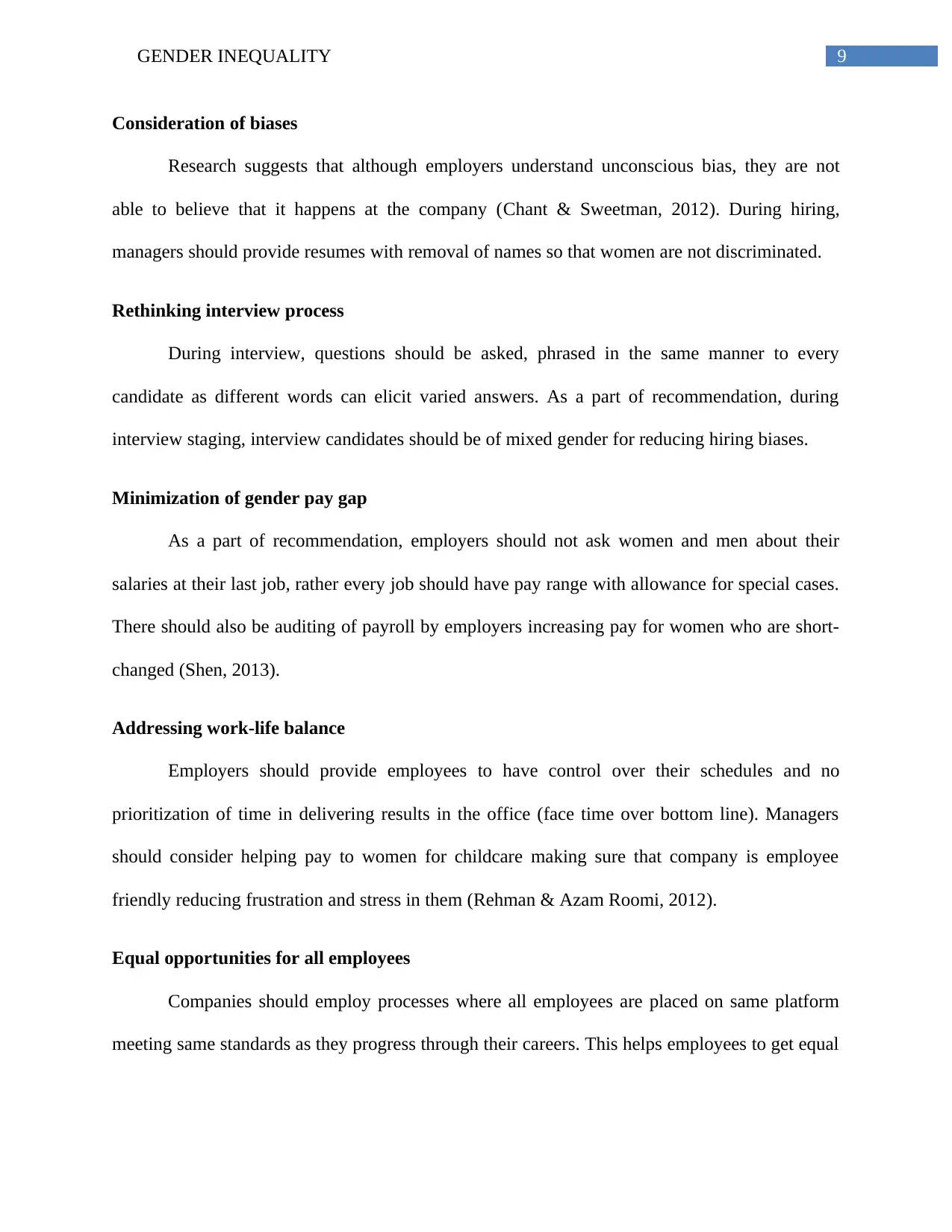
9GENDER INEQUALITY
Consideration of biases
Research suggests that although employers understand unconscious bias, they are not
able to believe that it happens at the company (Chant & Sweetman, 2012). During hiring,
managers should provide resumes with removal of names so that women are not discriminated.
Rethinking interview process
During interview, questions should be asked, phrased in the same manner to every
candidate as different words can elicit varied answers. As a part of recommendation, during
interview staging, interview candidates should be of mixed gender for reducing hiring biases.
Minimization of gender pay gap
As a part of recommendation, employers should not ask women and men about their
salaries at their last job, rather every job should have pay range with allowance for special cases.
There should also be auditing of payroll by employers increasing pay for women who are short-
changed (Shen, 2013).
Addressing work-life balance
Employers should provide employees to have control over their schedules and no
prioritization of time in delivering results in the office (face time over bottom line). Managers
should consider helping pay to women for childcare making sure that company is employee
friendly reducing frustration and stress in them (Rehman & Azam Roomi, 2012).
Equal opportunities for all employees
Companies should employ processes where all employees are placed on same platform
meeting same standards as they progress through their careers. This helps employees to get equal
Consideration of biases
Research suggests that although employers understand unconscious bias, they are not
able to believe that it happens at the company (Chant & Sweetman, 2012). During hiring,
managers should provide resumes with removal of names so that women are not discriminated.
Rethinking interview process
During interview, questions should be asked, phrased in the same manner to every
candidate as different words can elicit varied answers. As a part of recommendation, during
interview staging, interview candidates should be of mixed gender for reducing hiring biases.
Minimization of gender pay gap
As a part of recommendation, employers should not ask women and men about their
salaries at their last job, rather every job should have pay range with allowance for special cases.
There should also be auditing of payroll by employers increasing pay for women who are short-
changed (Shen, 2013).
Addressing work-life balance
Employers should provide employees to have control over their schedules and no
prioritization of time in delivering results in the office (face time over bottom line). Managers
should consider helping pay to women for childcare making sure that company is employee
friendly reducing frustration and stress in them (Rehman & Azam Roomi, 2012).
Equal opportunities for all employees
Companies should employ processes where all employees are placed on same platform
meeting same standards as they progress through their careers. This helps employees to get equal
Secure Best Marks with AI Grader
Need help grading? Try our AI Grader for instant feedback on your assignments.
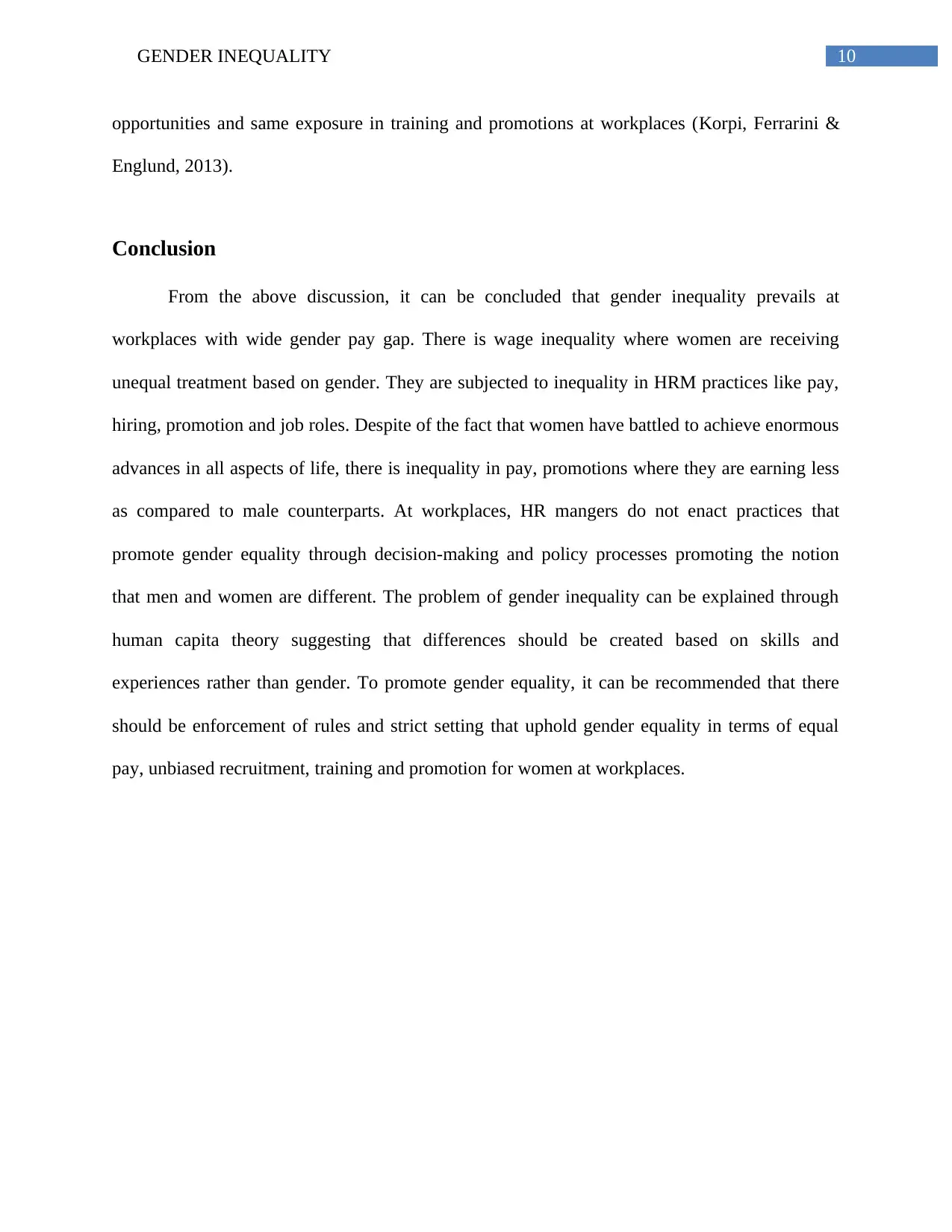
10GENDER INEQUALITY
opportunities and same exposure in training and promotions at workplaces (Korpi, Ferrarini &
Englund, 2013).
Conclusion
From the above discussion, it can be concluded that gender inequality prevails at
workplaces with wide gender pay gap. There is wage inequality where women are receiving
unequal treatment based on gender. They are subjected to inequality in HRM practices like pay,
hiring, promotion and job roles. Despite of the fact that women have battled to achieve enormous
advances in all aspects of life, there is inequality in pay, promotions where they are earning less
as compared to male counterparts. At workplaces, HR mangers do not enact practices that
promote gender equality through decision-making and policy processes promoting the notion
that men and women are different. The problem of gender inequality can be explained through
human capita theory suggesting that differences should be created based on skills and
experiences rather than gender. To promote gender equality, it can be recommended that there
should be enforcement of rules and strict setting that uphold gender equality in terms of equal
pay, unbiased recruitment, training and promotion for women at workplaces.
opportunities and same exposure in training and promotions at workplaces (Korpi, Ferrarini &
Englund, 2013).
Conclusion
From the above discussion, it can be concluded that gender inequality prevails at
workplaces with wide gender pay gap. There is wage inequality where women are receiving
unequal treatment based on gender. They are subjected to inequality in HRM practices like pay,
hiring, promotion and job roles. Despite of the fact that women have battled to achieve enormous
advances in all aspects of life, there is inequality in pay, promotions where they are earning less
as compared to male counterparts. At workplaces, HR mangers do not enact practices that
promote gender equality through decision-making and policy processes promoting the notion
that men and women are different. The problem of gender inequality can be explained through
human capita theory suggesting that differences should be created based on skills and
experiences rather than gender. To promote gender equality, it can be recommended that there
should be enforcement of rules and strict setting that uphold gender equality in terms of equal
pay, unbiased recruitment, training and promotion for women at workplaces.
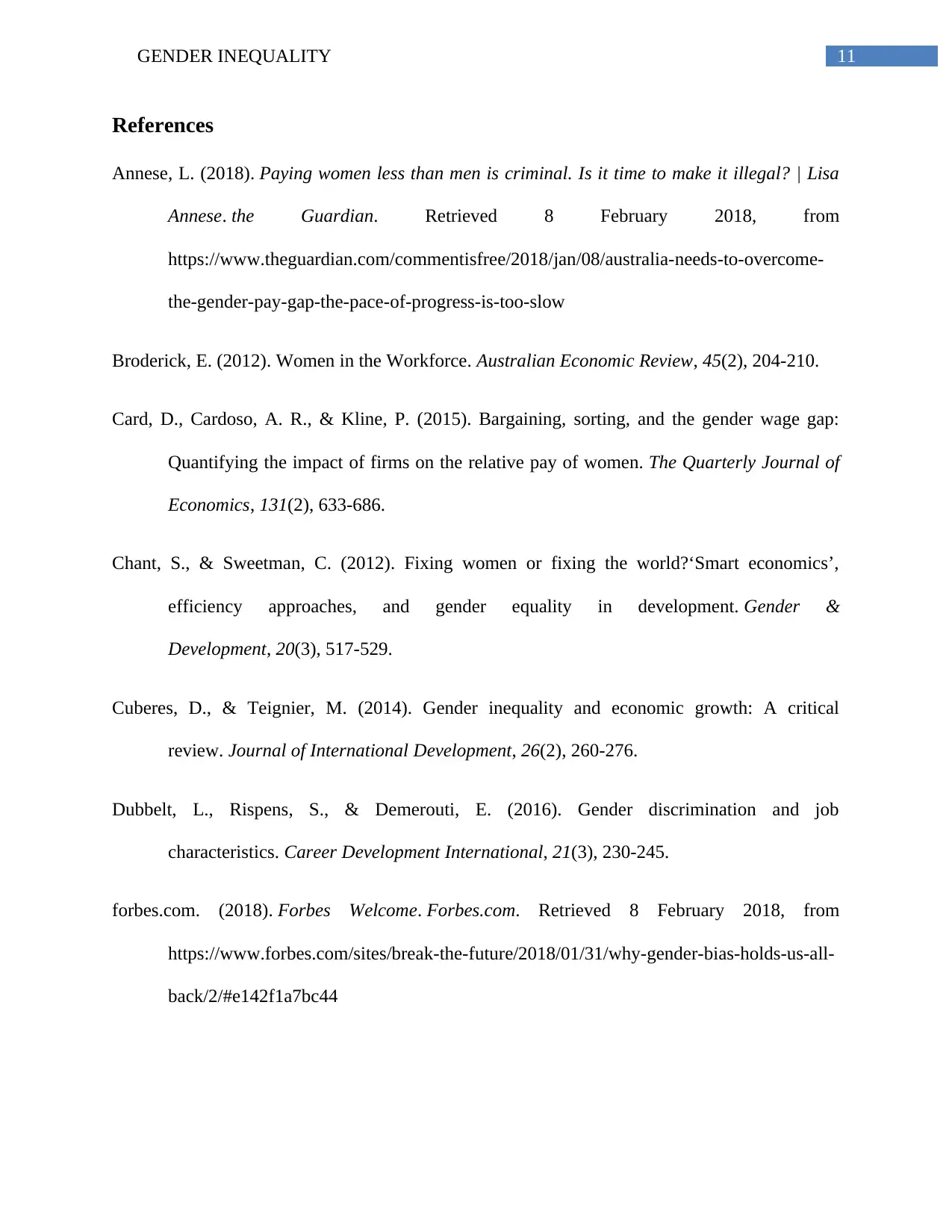
11GENDER INEQUALITY
References
Annese, L. (2018). Paying women less than men is criminal. Is it time to make it illegal? | Lisa
Annese. the Guardian. Retrieved 8 February 2018, from
https://www.theguardian.com/commentisfree/2018/jan/08/australia-needs-to-overcome-
the-gender-pay-gap-the-pace-of-progress-is-too-slow
Broderick, E. (2012). Women in the Workforce. Australian Economic Review, 45(2), 204-210.
Card, D., Cardoso, A. R., & Kline, P. (2015). Bargaining, sorting, and the gender wage gap:
Quantifying the impact of firms on the relative pay of women. The Quarterly Journal of
Economics, 131(2), 633-686.
Chant, S., & Sweetman, C. (2012). Fixing women or fixing the world?‘Smart economics’,
efficiency approaches, and gender equality in development. Gender &
Development, 20(3), 517-529.
Cuberes, D., & Teignier, M. (2014). Gender inequality and economic growth: A critical
review. Journal of International Development, 26(2), 260-276.
Dubbelt, L., Rispens, S., & Demerouti, E. (2016). Gender discrimination and job
characteristics. Career Development International, 21(3), 230-245.
forbes.com. (2018). Forbes Welcome. Forbes.com. Retrieved 8 February 2018, from
https://www.forbes.com/sites/break-the-future/2018/01/31/why-gender-bias-holds-us-all-
back/2/#e142f1a7bc44
References
Annese, L. (2018). Paying women less than men is criminal. Is it time to make it illegal? | Lisa
Annese. the Guardian. Retrieved 8 February 2018, from
https://www.theguardian.com/commentisfree/2018/jan/08/australia-needs-to-overcome-
the-gender-pay-gap-the-pace-of-progress-is-too-slow
Broderick, E. (2012). Women in the Workforce. Australian Economic Review, 45(2), 204-210.
Card, D., Cardoso, A. R., & Kline, P. (2015). Bargaining, sorting, and the gender wage gap:
Quantifying the impact of firms on the relative pay of women. The Quarterly Journal of
Economics, 131(2), 633-686.
Chant, S., & Sweetman, C. (2012). Fixing women or fixing the world?‘Smart economics’,
efficiency approaches, and gender equality in development. Gender &
Development, 20(3), 517-529.
Cuberes, D., & Teignier, M. (2014). Gender inequality and economic growth: A critical
review. Journal of International Development, 26(2), 260-276.
Dubbelt, L., Rispens, S., & Demerouti, E. (2016). Gender discrimination and job
characteristics. Career Development International, 21(3), 230-245.
forbes.com. (2018). Forbes Welcome. Forbes.com. Retrieved 8 February 2018, from
https://www.forbes.com/sites/break-the-future/2018/01/31/why-gender-bias-holds-us-all-
back/2/#e142f1a7bc44
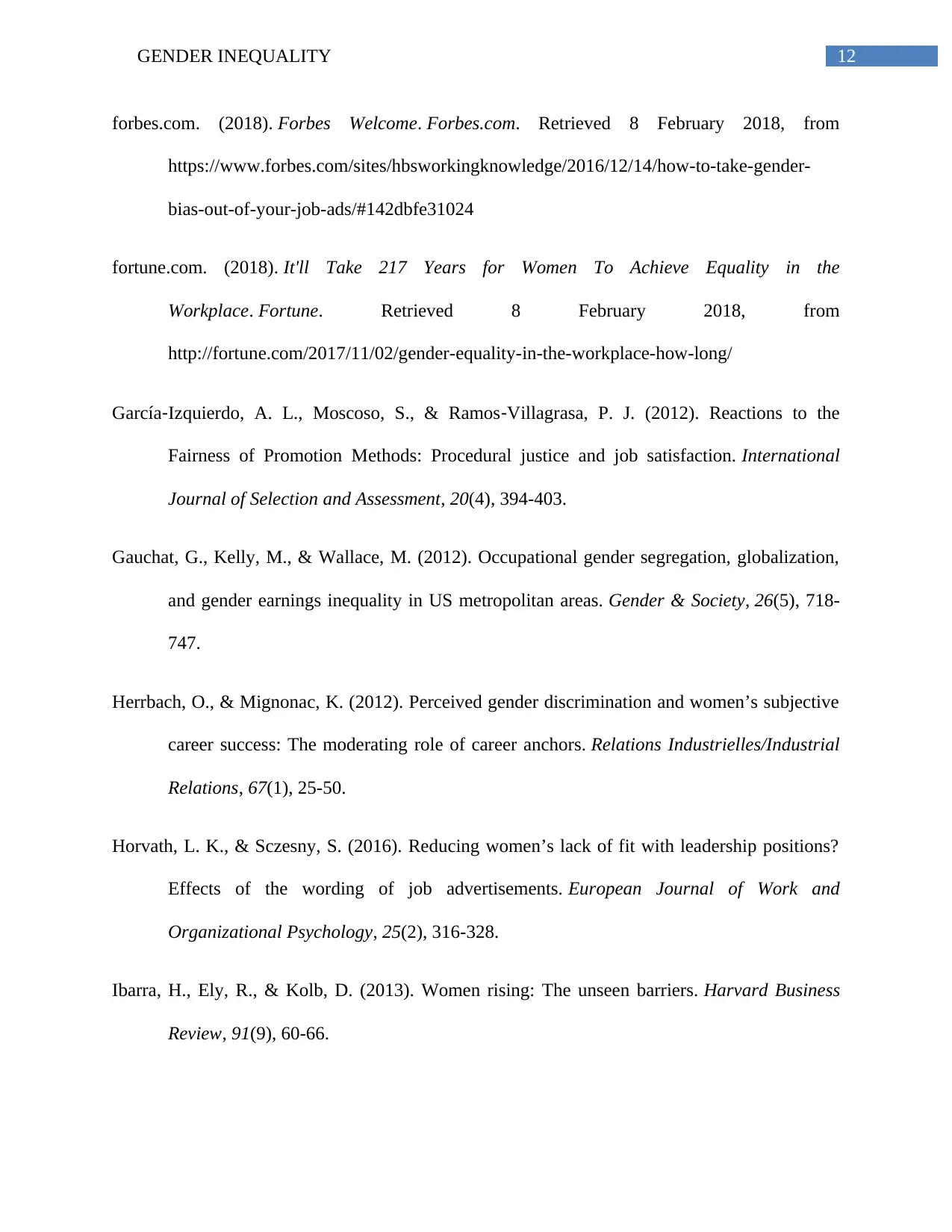
12GENDER INEQUALITY
forbes.com. (2018). Forbes Welcome. Forbes.com. Retrieved 8 February 2018, from
https://www.forbes.com/sites/hbsworkingknowledge/2016/12/14/how-to-take-gender-
bias-out-of-your-job-ads/#142dbfe31024
fortune.com. (2018). It'll Take 217 Years for Women To Achieve Equality in the
Workplace. Fortune. Retrieved 8 February 2018, from
http://fortune.com/2017/11/02/gender-equality-in-the-workplace-how-long/
García‐Izquierdo, A. L., Moscoso, S., & Ramos‐Villagrasa, P. J. (2012). Reactions to the
Fairness of Promotion Methods: Procedural justice and job satisfaction. International
Journal of Selection and Assessment, 20(4), 394-403.
Gauchat, G., Kelly, M., & Wallace, M. (2012). Occupational gender segregation, globalization,
and gender earnings inequality in US metropolitan areas. Gender & Society, 26(5), 718-
747.
Herrbach, O., & Mignonac, K. (2012). Perceived gender discrimination and women’s subjective
career success: The moderating role of career anchors. Relations Industrielles/Industrial
Relations, 67(1), 25-50.
Horvath, L. K., & Sczesny, S. (2016). Reducing women’s lack of fit with leadership positions?
Effects of the wording of job advertisements. European Journal of Work and
Organizational Psychology, 25(2), 316-328.
Ibarra, H., Ely, R., & Kolb, D. (2013). Women rising: The unseen barriers. Harvard Business
Review, 91(9), 60-66.
forbes.com. (2018). Forbes Welcome. Forbes.com. Retrieved 8 February 2018, from
https://www.forbes.com/sites/hbsworkingknowledge/2016/12/14/how-to-take-gender-
bias-out-of-your-job-ads/#142dbfe31024
fortune.com. (2018). It'll Take 217 Years for Women To Achieve Equality in the
Workplace. Fortune. Retrieved 8 February 2018, from
http://fortune.com/2017/11/02/gender-equality-in-the-workplace-how-long/
García‐Izquierdo, A. L., Moscoso, S., & Ramos‐Villagrasa, P. J. (2012). Reactions to the
Fairness of Promotion Methods: Procedural justice and job satisfaction. International
Journal of Selection and Assessment, 20(4), 394-403.
Gauchat, G., Kelly, M., & Wallace, M. (2012). Occupational gender segregation, globalization,
and gender earnings inequality in US metropolitan areas. Gender & Society, 26(5), 718-
747.
Herrbach, O., & Mignonac, K. (2012). Perceived gender discrimination and women’s subjective
career success: The moderating role of career anchors. Relations Industrielles/Industrial
Relations, 67(1), 25-50.
Horvath, L. K., & Sczesny, S. (2016). Reducing women’s lack of fit with leadership positions?
Effects of the wording of job advertisements. European Journal of Work and
Organizational Psychology, 25(2), 316-328.
Ibarra, H., Ely, R., & Kolb, D. (2013). Women rising: The unseen barriers. Harvard Business
Review, 91(9), 60-66.
Paraphrase This Document
Need a fresh take? Get an instant paraphrase of this document with our AI Paraphraser
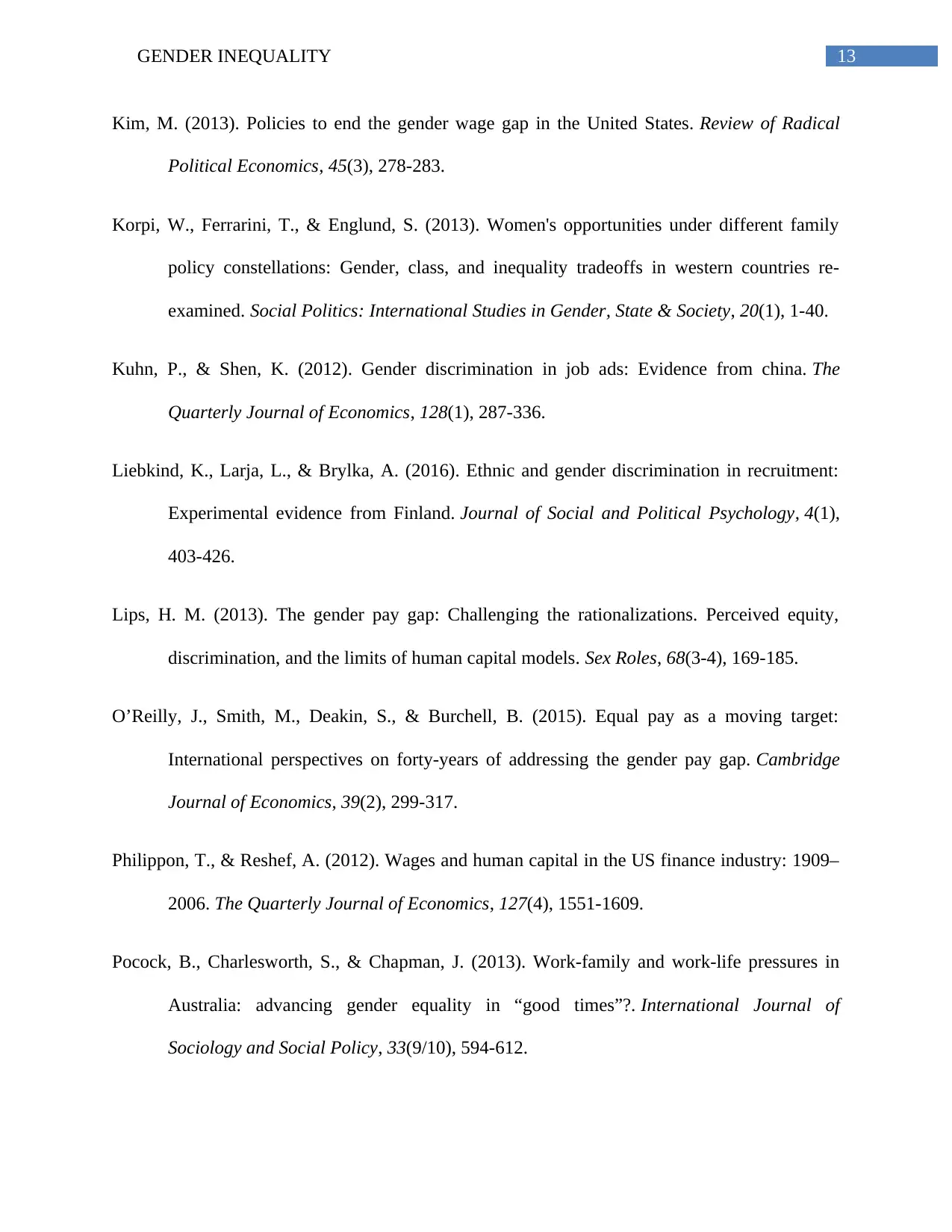
13GENDER INEQUALITY
Kim, M. (2013). Policies to end the gender wage gap in the United States. Review of Radical
Political Economics, 45(3), 278-283.
Korpi, W., Ferrarini, T., & Englund, S. (2013). Women's opportunities under different family
policy constellations: Gender, class, and inequality tradeoffs in western countries re-
examined. Social Politics: International Studies in Gender, State & Society, 20(1), 1-40.
Kuhn, P., & Shen, K. (2012). Gender discrimination in job ads: Evidence from china. The
Quarterly Journal of Economics, 128(1), 287-336.
Liebkind, K., Larja, L., & Brylka, A. (2016). Ethnic and gender discrimination in recruitment:
Experimental evidence from Finland. Journal of Social and Political Psychology, 4(1),
403-426.
Lips, H. M. (2013). The gender pay gap: Challenging the rationalizations. Perceived equity,
discrimination, and the limits of human capital models. Sex Roles, 68(3-4), 169-185.
O’Reilly, J., Smith, M., Deakin, S., & Burchell, B. (2015). Equal pay as a moving target:
International perspectives on forty-years of addressing the gender pay gap. Cambridge
Journal of Economics, 39(2), 299-317.
Philippon, T., & Reshef, A. (2012). Wages and human capital in the US finance industry: 1909–
2006. The Quarterly Journal of Economics, 127(4), 1551-1609.
Pocock, B., Charlesworth, S., & Chapman, J. (2013). Work-family and work-life pressures in
Australia: advancing gender equality in “good times”?. International Journal of
Sociology and Social Policy, 33(9/10), 594-612.
Kim, M. (2013). Policies to end the gender wage gap in the United States. Review of Radical
Political Economics, 45(3), 278-283.
Korpi, W., Ferrarini, T., & Englund, S. (2013). Women's opportunities under different family
policy constellations: Gender, class, and inequality tradeoffs in western countries re-
examined. Social Politics: International Studies in Gender, State & Society, 20(1), 1-40.
Kuhn, P., & Shen, K. (2012). Gender discrimination in job ads: Evidence from china. The
Quarterly Journal of Economics, 128(1), 287-336.
Liebkind, K., Larja, L., & Brylka, A. (2016). Ethnic and gender discrimination in recruitment:
Experimental evidence from Finland. Journal of Social and Political Psychology, 4(1),
403-426.
Lips, H. M. (2013). The gender pay gap: Challenging the rationalizations. Perceived equity,
discrimination, and the limits of human capital models. Sex Roles, 68(3-4), 169-185.
O’Reilly, J., Smith, M., Deakin, S., & Burchell, B. (2015). Equal pay as a moving target:
International perspectives on forty-years of addressing the gender pay gap. Cambridge
Journal of Economics, 39(2), 299-317.
Philippon, T., & Reshef, A. (2012). Wages and human capital in the US finance industry: 1909–
2006. The Quarterly Journal of Economics, 127(4), 1551-1609.
Pocock, B., Charlesworth, S., & Chapman, J. (2013). Work-family and work-life pressures in
Australia: advancing gender equality in “good times”?. International Journal of
Sociology and Social Policy, 33(9/10), 594-612.
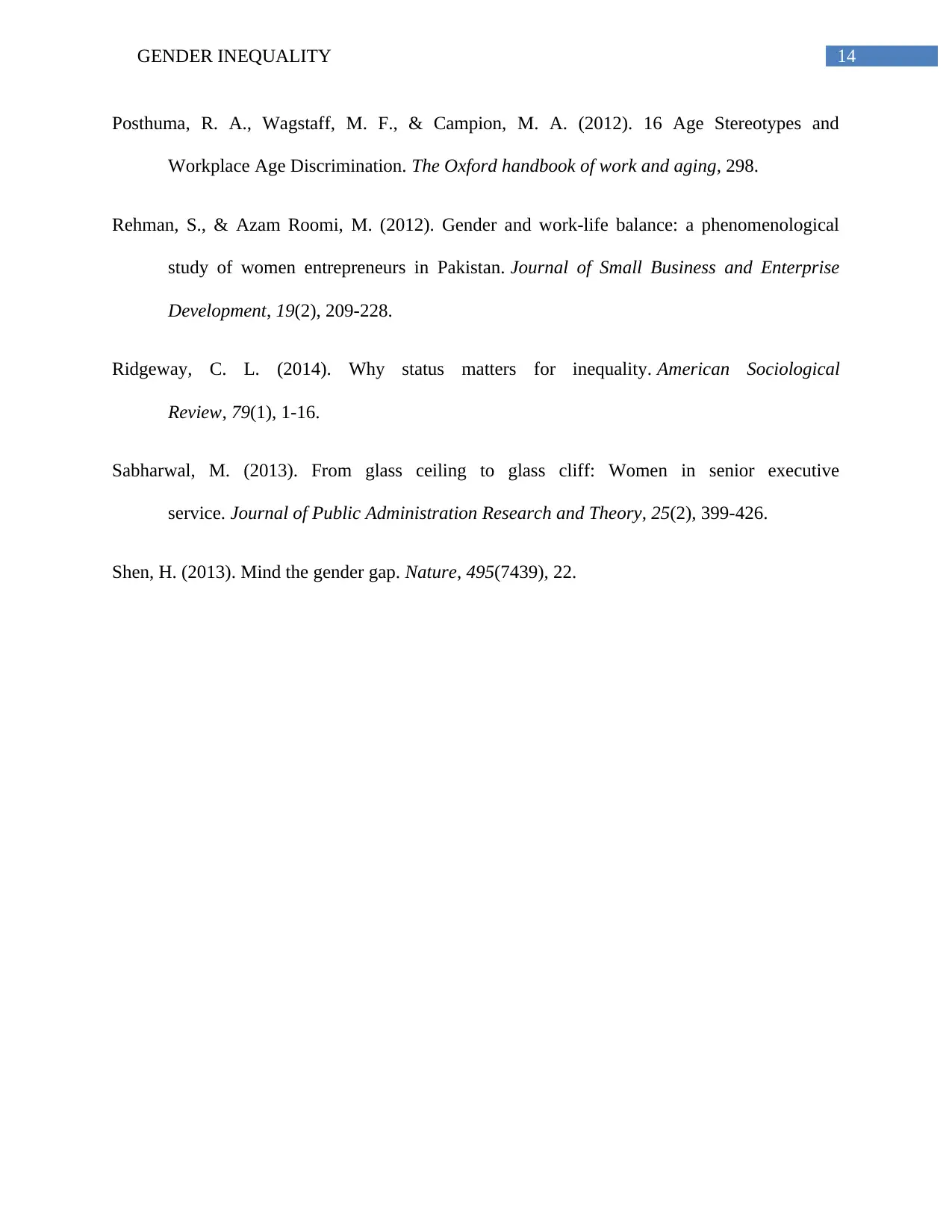
14GENDER INEQUALITY
Posthuma, R. A., Wagstaff, M. F., & Campion, M. A. (2012). 16 Age Stereotypes and
Workplace Age Discrimination. The Oxford handbook of work and aging, 298.
Rehman, S., & Azam Roomi, M. (2012). Gender and work-life balance: a phenomenological
study of women entrepreneurs in Pakistan. Journal of Small Business and Enterprise
Development, 19(2), 209-228.
Ridgeway, C. L. (2014). Why status matters for inequality. American Sociological
Review, 79(1), 1-16.
Sabharwal, M. (2013). From glass ceiling to glass cliff: Women in senior executive
service. Journal of Public Administration Research and Theory, 25(2), 399-426.
Shen, H. (2013). Mind the gender gap. Nature, 495(7439), 22.
Posthuma, R. A., Wagstaff, M. F., & Campion, M. A. (2012). 16 Age Stereotypes and
Workplace Age Discrimination. The Oxford handbook of work and aging, 298.
Rehman, S., & Azam Roomi, M. (2012). Gender and work-life balance: a phenomenological
study of women entrepreneurs in Pakistan. Journal of Small Business and Enterprise
Development, 19(2), 209-228.
Ridgeway, C. L. (2014). Why status matters for inequality. American Sociological
Review, 79(1), 1-16.
Sabharwal, M. (2013). From glass ceiling to glass cliff: Women in senior executive
service. Journal of Public Administration Research and Theory, 25(2), 399-426.
Shen, H. (2013). Mind the gender gap. Nature, 495(7439), 22.
1 out of 15
Related Documents
Your All-in-One AI-Powered Toolkit for Academic Success.
+13062052269
info@desklib.com
Available 24*7 on WhatsApp / Email
![[object Object]](/_next/static/media/star-bottom.7253800d.svg)
Unlock your academic potential
© 2024 | Zucol Services PVT LTD | All rights reserved.





